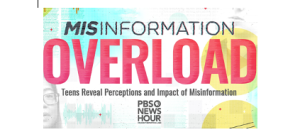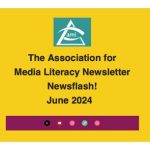Information Literacy and Misleading Graphs
https://srlmisinformationoverload.tumblr.com/
This lesson was created as the culminating project in the The Association for Media Literacy’s Spring 2022 Additional Qualifications Course.
The AML is grateful to Jennifer Kerwood for her creativity and permission to share this lesson. Please credit Jennifer Kerwood when you share the lesson.
by Jennifer Kerwood OCT
Grade: 6
Time: 4-6 double period blocks
Cross- Curricular: Media Literacy, Math, Language (Reading, Oral Communication)
Description
In this lesson students examine bias (producer and consumer) and various messages (values, social, and/or political) in media. They learn how these concepts are represented in various media forms and how to spot them. Students closely examine misleading graphs as forms of media. They then create a tweet that includes a misleading graph.
Curriculum Expectations
Media Literacy
Understanding Media Texts
1.2 Making Inferences/Interpreting Messages
1.3 Responding to and Evaluating Texts
1.5 Point of View
Understanding Media Forms, Conventions, and Techniques
2.2 Conventions and Techniques
Creating Media Texts
3.1 Purpose and Audience
3.4 Producing Media Texts
Reflecting on Media Literacy Skills and Strategies
4.1 Metacognition
Math
Data Literacy
Data Visualization
D1.3 and D1.4
Data Analysis
D1.5 and D1.6
Language
Oral Communication
Listening to Understand
1.2 Active Listening Strategies
Speaking to Communicate
2.2 Interactive Strategies
2.3 Clarity and Coherence
Reading
Reading for Meaning
1.5 Making Inferences/Interpreting Texts
1.6 Extending Understanding
1.9 Point of View
Understanding Form and Style
2.3 Text Features
Media Literacy Concepts
Key Concepts
2. Media Construct Versions of Reality
3. Audiences Negotiate Meaning
5. Media Communicate Values Messages
6. Media Communicate Political and Social Messages
7. Form and Content are Closely Related in Each Medium
Triangled Questions
Text
What might be this media experience’s (implicit and explicit) messages?
What values are being promoted?
Whose point of view do the values represent?
Audience
Who is the target audience for this text?
How might I change this text to make it more effective?
How might this text be changing society?
Production
Who produced this text?
For what purpose(s) was it produced?
Who profits from the consumption of this text?
Fake News Triangle
Text
Does it use verifiable facts and information; sources; contain links?
How might its form- blog, tweet, editorial- affect its credibility?
What values are promoted?
Audience
Might the fact that it is trending influence you to believe or to suspect the news?
Are there elements in this news that appeal to your biases? How?
How might this news story be changing society?
Production
Search multiple sites for this news. Can you validate it?
On which platform(s) is the news posted? What might you infer about the news story’s purpose from knowing this?
Who might gain- and who might suffer- from the consumption of this news?
How?
Goals
* Students will develop an understanding that media contain biases and will learn how to navigate various sources of media
* Students will consider how values messages are portrayed through media
* Students will identify some of the advertising techniques used in graphs and how they can be misleading
* Students will use what they have learned to create a misleading graph/tweet to portray a specific message
Resources
* Projector/Smart Board
* Laptop
* News Articles (same topic, different sources)
* Graphic Organizer (news articles)
* Chromebooks
* Graphic Organizer (examining graphs)
* Chart Paper (or equivalent)
* Art supplies (markers, paint, scissors, etc.)
Differentiated Instruction
* Audio, visual, hands on, and computer activities
* Opportunities for whole class, partner, individual work
* Checks for understanding done through oral communication and written responses
* Closed captions for all video-related tasks
* Graphic organizers for focus and organization
Assessment
Assessment for Learning
* Small group and class discussions
* Observation notes
* Padlet
Assessment as Learning
* Jigsaw activity
* Group presentations and discussion
* Padlet
* Production task check-in
Assessment of Learning
* Production task
* Gallery walk
Lesson 1 (Set-up)
Minds On
Watch video: Google Nose
Class Discussion
* Did you believe it? Why or Why not?
* Why might someone fall for this advertisement?
* What aspects of this video make it feel believable?
Action
Think-Pair-Share
How might we determine if the media we experience is “real” or not?
Class Discussion/Lesson
* Thinking critically about the media we experience
Fact check
Check other sources
Verify the source
Use The CRAAP Test
* How to examine media for bias and why it’s important
Exploration
Small Groups Examine News Articles
* Each group will get a news article (same topic, but from different sources) to examine and complete a graphic organizer
Prompts:
Who produced this text and why?
Is this source credible? How do you know? Does it use verifiable facts and information?
How might its form affect its credibility?
What values are being promoted?/Whose point of view do the values represent?
Who is the target audience for this article? What are its implicit and explicit messages?
How might this article contribute to changing society?
Discussion
Jigsaw
* Students will return to their home groups to discuss their particular media source
* Similarities and differences will be examined
Early Finishers may watch videos from Misinformation Overload
Lesson 2
Minds On
Examine Graph
The UK’s progressive debate
Think-Pair-Share
* What do you notice about this graph? Look at the writing, the bars, and the numbers. Is there anything misleading about it?
* Who do you think published this graph?
- Action
Class Discussion/Lesson
* Discuss four ways to manipulate graphs
Y-axis (disproportionate scale making changes in data sem more or less significant)
X-axis (inconsistent data points)
Scale (improper scaling in pictograms)
Cherry picking (only including certain data points on graph to reinforce certain narratives)
Watch video: How to Spot a Misleading Graph
Exploration
Examine graphs- Small Groups
* Each group will get a graph to examine and complete a graphic organizer
How is this graph misrepresenting the data? How could you change this graph to make it more representative of the actual data?
What values are being promoted?/Whose point of view do the values represent?
Who is the target audience for this graph?
Who do you think produced this text and why?
How might this graph contribute to changing society?
Discussion
* Group presentations
* Class discussion
Lesson 3 (Extension)
Minds On
Padlet
Have you ever shared anything you weren’t sure was true?
How did you decide whether or not to share it?
Action
Play- Break the Fake Quiz (whole class)
Production
* In small groups students will create a tweet (see examples in activity above) that includes a misleading graph
* Each set of 2 groups will get an opposing scenario card with data and a goal. They must use parts or all of the data given to create a misleading graph that supports their goal and then embed it in a tweet
* Students will have 2 check-ins with teacher to discuss progress and expectations (assessment for learning)
Discussion
Gallery Walk
* Students will guess at each station the values being promoted, the point of view being expressed, and how the graph is misleading
Class Discussion/Presentations
* Groups will present their tweets to the class
* Class discussion on how audience perception matched (or didn’t match) with producers’ intent for each group
* Review what we have learned and how to apply this to future interactions with news media, especially those with graphs



